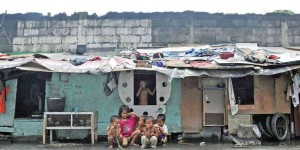Poverty numbers unchanged, survey shows

An estimated 10.4 million Filipino families described themselves as poor, while around 8.5 million families said they were food-poor over the past three months, according to a recent survey by the Social Weather Stations. INQUIRER PHOTO
MANILA, Philippines—An estimated 10.4 million Filipino families described themselves as poor, while around 8.5 million families said they were food-poor over the past three months, according to a recent survey by the Social Weather Stations (SWS).
Both numbers are similar to the March figures, considering the survey’s error margin of plus or minus three percentage points.
The Second Quarter 2013 Social Weather Report, conducted from June 28 to 30 and first published in BusinessWorld, showed that 49 percent of Filipinos said they were poor, down by three percent from the 52 percent or 10.6 million families in March.
It also found that 40 percent said they were food-poor, up from 39 percent or 7.9 million families in the previous quarter.
In its survey on self-rated poverty, SWS asked 1,200 household heads nationwide to plot their family on a card with indicators stating “not poor,” “on the line” and “poor.”
Article continues after this advertisementSelf-rated poverty fell the most in the Visayas, at 57 percent, down by eight points from the 65 percent in March.
Article continues after this advertisementPoverty also fell in Mindanao (from 53 percent in March to 47 percent in June), Metro Manila (from 42 percent to 40 percent) and Luzon outside Metro Manila (from 50 percent to 48 percent), but within the survey’s error margin for area percentages of plus or minus six percentage points.
For self-rated food poverty, respondents were told to plot their family on a card indicating whether they were “not poor,” “on the line” or “poor” on the basis of their food situation over the past three months.
Self-rated food poverty rose in Luzon outside Metro Manila at 42 percent, up by six points from 36 percent in March.
It fell in Mindanao (from 43 percent in March to 39 percent in June), the Visayas (from 46 percent to 44 percent) and Metro Manila (from 28 percent to 27 percent).
These self-rated food poverty ratings fell within the survey’s error margin for area percentages of plus or minus six percentage points.
Under the Aquino administration, self-rated poverty ratings ranged between 45 percent and 55 percent, which were registered in December 2011 and March 2012, respectively.
Self-rated food poverty ratings hovered between 35 percent and 45 percent, which were recorded in August and March 2012, respectively.
In April, the National Statistical Coordination Board (NSCB) said the poverty incidence in the country was estimated at 27.9 percent in the first semester of 2012, and was statistically unchanged from the 2006 and 2009 first semester figures of 28.8 percent and 28.6 percent, respectively.
The NSCB also estimated the poverty incidence among families at 22.3 percent in the first semester of 2012, and 23.4 percent and 22.9 percent during the same periods in 2006 and 2009, respectively.
The board also put the estimated cost of poverty eradication at P79.7 billion for the first semester of 2012. Inquirer Research